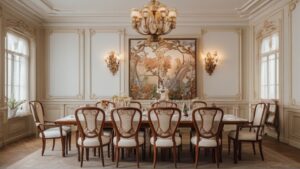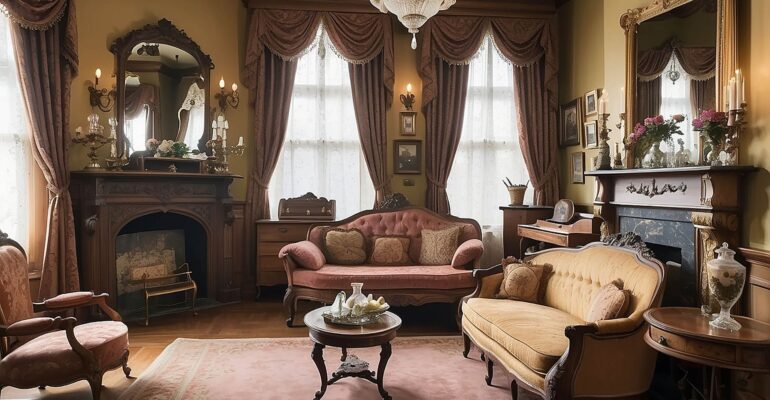Historical Design Styles: Shaping Modern Creativity
October 28, 2024 2024-10-28 12:09Historical Design Styles: Shaping Modern Creativity
At Dhruva College of Fashion Technology, we celebrate creativity and innovation in fashion and interior design. While contemporary trends excite us, understanding the historical context that shapes these trends remains essential. By studying historical design styles, our students gain valuable insights that inform their future creations. Let’s explore key historical design movements, their characteristics, and how they influence modern design at Dhruva College.
1. Victorian Era (1837-1901)
The Victorian era marks a time of significant change in both society and design. Influenced by the Industrial Revolution, this period introduces new materials and technologies, allowing for elaborate and ornate designs.
Fashion: During this era, fashion features structured garments, corsets, and layers. Women’s dresses showcase voluminous skirts supported by petticoats, while men sport tailored suits with high collars. Designers use rich, luxurious fabrics adorned with lace and intricate embroidery. The emphasis on modesty leads to high necklines and long sleeves.
Interior: In Victorian interiors, opulence reigns. Heavy drapes, intricate wallpaper, and dark wood furnishings fill the space. Parlor rooms overflow with elaborate furniture arranged to facilitate social gatherings. Decorative arts flourish, focusing on craftsmanship and detail.
At Dhruva College, students explore how to adapt Victorian richness to modern design. By understanding these historical elements, they learn to incorporate elegance and detail into their contemporary fashion and interiors.
2. Art Nouveau (1890-1910)
Emerging in the late 19th century, Art Nouveau captivates with its organic forms, flowing lines, and nature-inspired motifs. This movement aims to break away from traditional design principles, emphasizing harmony between art and everyday life.
Fashion: Art Nouveau celebrates femininity with soft, flowing silhouettes and intricate detailing. Designers embrace natural motifs, incorporating floral patterns and curvilinear shapes into garments. They choose lightweight fabrics, enhancing the ethereal quality of their designs.
Interior: Art Nouveau interiors feature curvilinear furniture, stained glass windows, and decorative arts echoing natural forms. The style emphasizes craftsmanship, with artisans creating unique pieces that blend function and beauty.
At Dhruva College, we encourage students to integrate nature into their designs. The principles of Art Nouveau inspire them to experiment with organic shapes and create harmonious environments that reflect the beauty of the natural world.

3. Bauhaus (1919-1933)
The Bauhaus movement revolutionizes design by emphasizing simplicity, functionality, and the integration of art and industry. Founded by Walter Gropius in Germany, Bauhaus seeks to create a new aesthetic that reflects modernity.
Fashion: Bauhaus fashion focuses on minimalist designs and utilitarian clothing. Designers prioritize practical, comfortable garments that don’t sacrifice style. Geometric shapes and a limited color palette characterize this fashion, promoting a clean and sophisticated look.
Interior: Bauhaus introduces the concept of “form follows function” in interior design. Designers create furniture with usability in mind, often utilizing industrial materials such as metal and glass. Open spaces and minimalist decor become hallmarks of this style, creating environments that feel spacious and uncluttered.
At Dhruva College, students study the Bauhaus philosophy to learn how to create designs that balance aesthetics and practicality. They apply these principles to develop innovative solutions that cater to modern consumers’ needs.
4. Mid-Century Modern (1945-1969)
Mid-century modern design emerges after World War II, known for its clean lines, organic forms, and connection to nature. This period witnesses a shift towards more relaxed and informal designs, reflecting changing lifestyles.
Fashion: Mid-century fashion embraces bold colors and geometric patterns. Designers like Christian Dior and Yves Saint Laurent push the boundaries of traditional silhouettes, using innovative fabrics and techniques to create playful and dynamic designs.
Interior: Mid-century modern interiors feature open floor plans, large windows, and an emphasis on natural light. Furniture remains functional yet stylish, often incorporating materials like molded plywood and fiberglass. This aesthetic focuses on simplicity and a seamless connection to the outdoors.
At Dhruva College, students draw inspiration from the Mid-century modern movement as they explore contemporary design. By understanding this era, they create spaces and garments that embody simplicity and elegance, appealing to modern sensibilities.

5. Postmodernism (1970s-1990s)
Postmodernism marks a departure from the rigidity of previous design movements, celebrating eclecticism, irony, and playful experimentation. This period encourages designers to break the rules and mix styles in innovative ways.
Fashion: In fashion, postmodernism embraces vibrant colors, unexpected combinations, and a mix of historical references. Designers like Jean-Paul Gaultier and Vivienne Westwood challenge traditional notions of beauty and style, encouraging individuality.
Interior: Postmodern interior design showcases bold colors, varied textures, and a playful approach to space. It often includes kitsch elements and a mix of different styles, creating environments that feel personal and unique.
At Dhruva College, we encourage students to explore their individuality and creativity, drawing inspiration from the playful spirit of postmodernism. This freedom to experiment fosters innovative thinking and helps them develop their distinctive design voice.
Conclusion
Understanding historical design styles proves crucial for aspiring designers at Dhruva College of Fashion Technology. By studying these influential movements, students appreciate the evolution of design and apply these lessons to their own work. Whether in fashion or interior design, history provides a rich tapestry of inspiration, helping students create meaningful and innovative designs that resonate with today’s audiences.
FAQs
1. What programs does Dhruva College offer?
Dhruva College offers a variety of programs, including undergraduate and diploma courses in fashion design, interior design, and textile design, among others.
2. Does the college offer internship opportunities?
Yes, Dhruva College emphasizes practical experience and often facilitates internships with industry partners. This allows students to gain hands-on experience and build valuable professional networks.
3. What facilities are available on campus?
The college features modern facilities, including design studios, computer labs, workshops, and classrooms. These resources support both theoretical learning and practical skill development.
4.How does Dhruva College support student creativity?
Dhruva College fosters creativity through various initiatives, including workshops, guest lectures, and collaborative projects. Students have the opportunity to experiment and explore their unique design perspectives.
5. Is there a focus on sustainable design practices?
Yes, Dhruva College emphasizes the importance of sustainability in both fashion and interior design. Students learn about eco-friendly materials and practices that promote responsible design.






